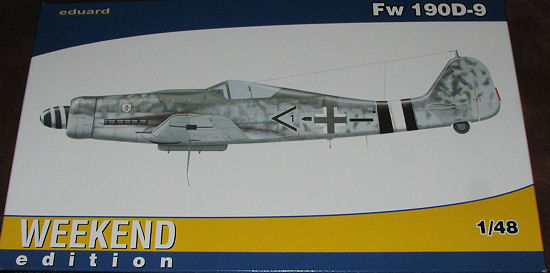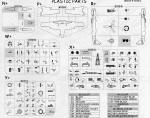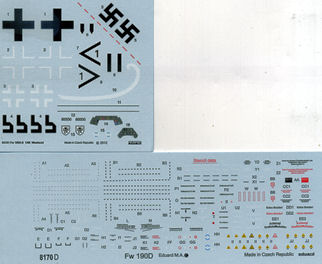
Eduard 1/48 FW-190D-9
| KIT #: | 84101 |
| PRICE: | $22.95 SRP |
| DECALS: | One option |
| REVIEWER: | Scott Van Aken |
| NOTES: | Weekend Edition |

| HISTORY |
The Fw 190 D (nicknamed the Dora; or Long-Nose Dora, "Langnasen-Dora") was intended to improve on the high-altitude performance of the A-series enough to make it useful against the American heavy bombers of the era. In the event, the D series was rarely used against the heavy-bomber raids, as the circumstances of the war in late 1944 meant that fighter-versus-fighter combat and ground attack missions took priority. A total of 1,805 D-9s were produced. Production started in August 1944.
With the D version the power plant was changed from the radial engine of earlier models to an in-line 12-cylinder inverted-Vee liquid-cooled engine. The Jumo 213A generated 1,750 PS (1,726 hp, 1,287 kW), and could produce 2,100 PS (2,071 hp, 1,545 kW) of emergency power with MW 50 injection, improving performance to 426 mph (686 km/h) at 21,650 ft (6,600 m). In order to fit the new engine in the Fw 190 fuselage while maintaining proper balance, both the nose and the tail of the aircraft were lengthened, adding nearly 1.52 m (4.99 ft) to the fuselage, bringing the overall length to 10.192 m (33.438 ft) versus the 9.10 m (29.9 ft) of the late war A-9 series. The lengthened tail required a straight-sided bay, 30 cm (12 in) long, spliced in forward of the rear angled joint and tail assembly of the fuselage. To further aid balance, the pilot's oxygen bottles were moved aft and located in the new bay. This gave the rear fuselage a "stretched" appearance.
Furthermore, the move to a V12 engine from a radial engine required more components to be factored into the design, most significantly the need for coolant radiators (radial engines are air-cooled). To keep the design as simple and as aerodynamic as possible, Tank used an annular radiator (the AJA 180 L) installed at the front of the engine, similar to the configuration used in the Jumo powered versions of the Junkers Ju 88. The annular radiator with its adjustable cooling gills resembled a radial engine installation, although the row of six short exhausts stacks on either side of the elongated engine cowling showed that Jumo 213 was an inverted vee-12 engine. While the first few Doras were fitted with the flat-top canopy, these were later replaced with the newer rounded top "blown" canopy first used on the A-8 model. With the canopy changes, the shoulder and head armour plating design was also changed. Some late model Doras were also fitted with the Ta 152 vertical stabilizer and rudder, often called "Big Tails" by the Luftwaffe ground crews and pilots, as seen on W.Nr. 500647 Brown 4 from 7./JG 26 and W.Nr. 500645 Black 6 from JG 2. The centreline weapons rack was changed to an ETC 504 with a simplified and much smaller mounting and fairing.
Early D-9s reached service without the MW 50 installation, but in the meantime Junkers produced a kit to increase manifold pressure (Ladedrucksteigerungs-Rüstsatz) that increased engine output by 150 PS to 1,900 PS, and was effective up to 5,000 m (16,400 ft) altitude. It was fitted immediately to D-9s delivered to the units from September, or retrofitted in the field by TAM. By the end of December, all operational Doras, 183 in total, were converted. From November 1944, a simplified methanol water (MW 50) system (Oldenburg) was fitted, which boosted output to 2,100 PS. By the end of 1944, 60 were delivered with the simplified MW 50 system or were at the point of entering service. The 115 L tank of the Oldenburg system would hold the MW 50 booster liquid, which was single purpose, while later systems were to be dual purpose, holding either MW 50 or additional fuel.
The fighter lacked the high turn rate and higher rate of roll of its close coupled radial-engined predecessor. It was a bit faster, however, with a maximum speed of 680 km/h (422 mph) at 6,600 meters (21,650 ft). Its 2,240 horsepower with methanol-water injection (MW 50) gave it an excellent acceleration in combat situations. It also climbed and dived more rapidly than the Fw 190A, and so proved well suited to the dive-and-zoom ambush tactics favored by the Schlageter pilots. Many of the early models were not equipped with tanks for methanol, which was in very short supply in any event. At low altitude, the top speed and acceleration of these examples were inferior to those of Allied fighters. Hans Hartigs recalled that only one of the first batch of Dora 9s received by the First Gruppe had methanol water injection, and the rest had a top speed of only 590 km/h (360 mph).
Owing to the failure of multiple attempts to create an effective next-generation 190, as well as the comments of some Luftwaffe pilots, expectations of the Dora project were low. These impressions were not helped by the fact that Tank made it very clear that he intended the D-9 to be a stopgap until the Ta 152 arrived. These negative opinions existed for some time until positive pilot feedback began arriving at Focke-Wulf and the Luftwaffe command structure. Sporting good handling and performance characteristics, the D-9 made an effective medium altitude, high speed interceptor, although its performance still fell away at altitudes above about 20,000 ft (6,100 m). When flown by capable pilots, the Fw 190D proved the equal of Allied types.
As it was used in the anti-fighter role, armament in the "D" was generally lighter compared to that of the earlier aircraft—usually the outer wing cannon were dropped so that the armament consisted of two 13 mm (.51 in) MG 131, with 400 rounds per gun, and two 20 mm MG 151/20E cannon with 250 rounds per gun; all four weapons were synchronized to fire through the propeller arc. The wings of the D-9 still had the electrical circuits and attachment points for the underwing WGr 21 rocket propelled mortar, although none appeared to have used these operationally. While inferior to the A-series in roll rate, the "D" was superior in turn rate, climb, dive and horizontal speed. The Dora still featured the same wing as the A-8, however, and was capable of carrying outer wing cannon as well, as demonstrated by the D-11 variant, with a three-stage supercharger and four wing cannon (two MG 151s and two MK 108s). The first Fw 190 D-9s started entering service in September 1944, with III./JG 54. It was quickly followed by other units including I./JG 26 which flew its last operations on the A-8s on 19 November 1944.
Some Fw 190 Ds served as fighter cover for Me 262 airfields, as the jet fighters were very vulnerable on take-off and landing. These special units were known as Platzsicherungstaffel (airfield defence squadrons).[62] One unit, known as the Würger-Staffel, was created in April 1945 by Leutnant Heinz Sachsenberg at the behest of Adolf Galland, and was part of JV 44. The role of the Staffel was to guard the airfield and JV 44's Messerschmitt Me 262s as they landed; as such the Fw 190s were supposed to take off before the jets and circle the airfield in pairs (a Rotte). However, to allow the 262s a clear run back to the airfield the 190s had to land before the jets, negating their protection. To help anti-aircraft artillery protecting the airfields to quickly identify friendly aircraft, the under-surfaces of the Würger-Staffel 190s were painted red with narrow white stripes.leading to the alternative nickname of Papageien Staffel (parrot squadron) from the bright red color.
| THE KIT |
 As
with other Weekend Edition kits, this is simply the same plastic as the
Profipak kits, but without any resin, photoetch, masks, or multiple
decal options. Everything else seems to be the same.
As
with other Weekend Edition kits, this is simply the same plastic as the
Profipak kits, but without any resin, photoetch, masks, or multiple
decal options. Everything else seems to be the same.
That includes the additional detail features of open cowl and inner wing cannon. Hopefully, building the closed version will not be the trial that doing this was with their 109 Weekend Edition kit as that was not a procedure I would care to repeat any time soon. However, I am going to be expecting the 'closed' option to be rife with poor fit. Surprise me, Eduard.
The plastic itself is very nicely molded as you would expect on modern Eduard kits. There is a full feature cockpit that includes raised instrument and console detail. I like that there is an instrument panel decal and would have liked to have seen a harness decal as well. Adding a ton of detail to the cockpit will be similar to 'modeling for God' as little will be seen past the seat and instruments as it is a tight cockpit.
There is only one markings option, which is typical for these
kits, but many of us will choose aftermarket for that. With that in
mind, the kit comes with both 'flat' and 'blown' canopies and their
attendant armor plating. Both smooth and treaded tires are also provided
and you can use either closed or open cowl flaps. I think I have used
the o pen
option on every 190D-9 kit that has offered them. The D-9 version had an
open wheel well where you could see the accessory section of the engine
and Eduard has included that feature, something many other kits have
missed. For under the fuselage, you can choose between a bomb and a drop
tank. Each has its own rack and those are also provided. Separate
ailerons are provided, but not separate flaps.
pen
option on every 190D-9 kit that has offered them. The D-9 version had an
open wheel well where you could see the accessory section of the engine
and Eduard has included that feature, something many other kits have
missed. For under the fuselage, you can choose between a bomb and a drop
tank. Each has its own rack and those are also provided. Separate
ailerons are provided, but not separate flaps.
Instructions are well drawn with detail images as needed. Color information seems to be Humbrol and Gunze paints. The markings option is for an RLM 83/75/76 aircraft with much of the lower wing in unpainted aluminum. This aircraft was from JG 4 at Rhein-Main in the last month of the war. The black Reich Defense bands will need to be painted, but the decal sheet does provide the trim decals for the outside. A very comprehensive data suite is provided.
| CONCLUSIONS |
This kit retails for less than many 1/72 kits and if you are going to build it as intended (panels open or off), I am sure it will be a delight to construct. As for the closed option, the jury is out on that one.
| REFERENCES |
http://en.wikipedia.org/wiki/Focke-Wulf_Fw_190
January 2013
Thanks to me and a moment of weakness for picking this one up.
If you would like your product reviewed fairly and fairly quickly, please contact the editor or see other details in the Note to Contributors.